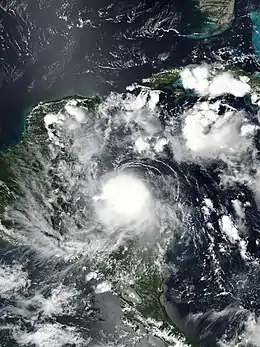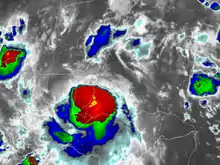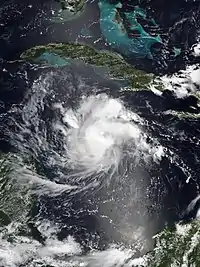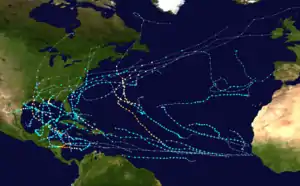Hurricane Nana (2020)
Hurricane Nana was a minimal Category 1 hurricane that caused moderate damage across the country of Belize in early September 2020. The sixteenth tropical cyclone, fourteenth named storm, and the fifth hurricane of the record-breaking 2020 Atlantic hurricane season, Nana originated from a tropical wave near the Lesser Antilles. The National Hurricane Center (NHC) began tracking the wave on August 27, giving it a low chance of formation. Contrary to predictions, the wave rapidly organized, though data failed to locate a closed circulation, and the system was not designated a tropical cyclone. However, the system continued organizing, and data from a hurricane hunter aircraft recorded tropical storm force winds along with a closed circulation; the NHC subsequently named the system Tropical Storm Nana on September 1. Nana rapidly intensified that day, though wind shear increased early the next day, preventing the storm from intensifying further. However, early on September 3, reconnaissance aircraft found that Nana had strengthened into a hurricane just before making landfall in Southern Belize. After landfall, it began to rapidly weaken. Early on September 4, its low-level center dissipated and it degenerated into a mid-level remnant low. The remnants moved into the Eastern Pacific, where they reformed into Tropical Storm Julio.
| Category 1 hurricane (SSHWS/NWS) | |
 Nana prior to peak intensity while approaching Belize on September 2 | |
| Formed | September 1, 2020 |
|---|---|
| Dissipated | September 4, 2020 |
| (Remnant low after September 3) | |
| Highest winds | 1-minute sustained: 75 mph (120 km/h) |
| Lowest pressure | 994 mbar (hPa); 29.35 inHg |
| Fatalities | None |
| Damage | ≥ $20 million (2020 USD) |
| Areas affected | Windward Islands, Jamaica, Cayman Islands, Honduras, Belize, Guatemala, Mexico |
| Part of the 2020 Atlantic hurricane season | |
Nana was the first hurricane to make landfall in Belize since Earl in 2016. Numerous watches and warnings were issued ahead of Nana for parts of Belize, Guatemala, Honduras and Mexico. The storm caused significant agriculture losses to Belize, but damage to infrastructure was minor. No casualties or injuries were reported from the storm.[1]
Meteorological history

On August 23, 2020, the National Hurricane Center (NHC) identified a westward moving tropical wave over West Africa.[2] A broad area of disorganized convection, primarily east of the wave axis, accompanied the system as it emerged over the Atlantic Ocean early the next day, producing a noticeable growth of convection across the Intertropical Convergence Zone (ITCZ).[3][4] Convection increased by August 27 as the system traversed the central Atlantic, and the NHC noted the possibility of gradual tropical cyclogenesis over the following days.[5] Little development occurred over the next few days as it approached the Windward Islands.[6] Upon entering the Caribbean Sea on August 30, the system started to organize with evidence of a broad surface low apparent on satellite-derived observations.[7] Convection gradually increased as the system continued west across the Caribbean and appeared well-organized on satellite imagery. Scatterometer data and ship observations revealed tropical storm-force winds south of Haiti and southeast of Jamaica early on September 1 and post-storm analysis indicated the system developed into a tropical storm at 06:00 UTC.[8][9] Operationally, the NHC did not name the system at that point because it was unclear whether it had a well-defined low-level-circulation ((LLC).[4] However, with the storm posing an imminent threat to Central America, the NHC initiated advisories on the system as Potential Tropical Cyclone Sixteen at 15:00 UTC.[10] Shortly thereafter, aircraft reconnaissance confirmed a well-defined surface low with winds of 70 mph (110 km/h) aloft with surface winds estimated at 50 mph (85 km/h) at this time. Accordingly, the system was reclassified as Tropical Storm Nana, marking the earliest formation of a season's fourteenth named storm, surpassing the previous record set by Hurricane Nate on September 6, 2005.[11][12] With a defined anticyclone aloft providing ample outflow, high sea surface temperatures, and low to moderate wind shear, steady intensification was expected.[13] The storm steadily strengthened, obtaining 1-minute sustained winds of 60 mph (95 km/h) at 18:00 UTC that same day.[4]

Shortly after becoming a mid-range tropical storm, moderate northerly shear of 15 knots halted the intensification trend and partially exposed the center of circulation.[4] Throughout September 2, Nana's winds remained steady at 60 mph, although it pressure continued to fall. Late that day, the shear abated some, allowing Nana to redevelop convection over its center and quickly intensify into a minimal hurricane at 03:00 UTC on September 3. Simultaneously, it reached its peak intensity of 75 mph (120 km/h) with a minimum central pressure of 994 mbar (29.36 inHg).[4][14] Three hours later, Nana made landfall between Dangriga and Placencia in Belize at the same intensity.[4] Nana rapidly weakened after landfall, dropping below hurricane status at 09:00 UTC and to tropical depression status at 18:00 UTC due to interaction with the mountainous terrain over Belize and Guatemala.[15][4] It then degenerated into a remnant low at 00:00 UTC on September 4 before its low-level center dissipated shortly thereafter, causing the NHC to issue their final advisory on the storm at 03:00 UTC on September 4.[4][16] The remnants of Nana then entered the Gulf of Tehuantepec, where they later redeveloped into Tropical Storm Julio in the Eastern Pacific on September 5.[4]
Preparations and impact

Multiple tropical storm watches and tropical storm warnings were issued ahead of Nana for parts of Belize and Honduras, with the former upgrading their warnings to hurricane warnings. After Nana had weakened below hurricane intensify following landfall at 09:00 UTC on September 3, all the hurricane warnings were cancelled. Additional warnings were all cancelled by 15:00 UTC, as Nana moved farther inland and continued to rapidly weaken.[17]
Windward Islands

Between August 29–30, the Barbados Met Office and Dominica Meteorological Service issued flash flood watches for their respective nations in anticipation of moderate to heavy rains from the precursor wave.[18][19] Météo-France alerted residents in Martinique of possible heavy rain and strong winds from the tropical wave on August 30–31.[20] The associated showers and thunderstorms produced up to 4.3 in (110 mm) of rain in Grand'Rivière and wind gusts to 52 mph (84 km/h) in Fonds-Saint-Denis.[21] Approximately 5,600 customers lost power in Le François, Vert-Pré, La Trinité, Tartane, and L'Ajoupa-Bouillon. EDF deployed power crews soon after the storm's passage.[20] Southern areas of Guadeloupe saw heavy rainfall; Goyave recorded a 12-hour accumulation of 3.8 in (96 mm). Nearby Îles des Saintes recorded 3.1 in (80 mm).[22] In St. Lucia, increased turbidity and clogging due to heavy rain forced the temporary closure of the Theobalds Treatment Plant which cut the water supply to residents in northern parts of the country.[23]
Belize
In preparation for Nana, residents of Belize packed hardware and grocery stores, despite the ongoing COVID-19 pandemic.[24] More than 4,000 people in the southern part of the country were evacuated to shelters provided by the government.[25] A station on Carrie Bow Caye reported a wind speed of 61 mph (98 km/h) as the storm came ashore.[26] Preliminary reports from southern Belize indicated that hundreds of acres of banana and plantain farm crops were lost to the storm. A week after the storm, it was reported that 960 acres of banana crops were entirely destroyed.[27][28] Damage assessment teams reported 7 damaged structures in Hopkins, 13 in Silk Grass and 4 homes in Dangriga with roof damage. Overall, Nana caused an estimated US$20 million in damage to banana crops in Belize.[29]
Elsewhere
In Jamaica Nana's rainfall caused some flooding in parts of Southern Jamaica. In Cayman Islands Nana's rainfall caused some minor flooding in some low-lying areas on Grand Cayman. In Honduras, Nana's rainfall caused flash flooding in Coxen Hole.[24] Guatemala reported heavy rains, especially along its border with Mexico. The country's national disaster coordinator reported no deaths. No one had been evacuated due to the storm in Guatemala.[25] In Mexico, the primary impact from Nana was heavy rainfall. A swath of up to 8 in (200 mm) was reported along Nana's path in Eastern Mexico.[30]
See also
- Tropical cyclones in 2020
- Other storms of the same name
- List of Category 1 Atlantic hurricanes
- Hurricane Fifi–Orlene (1974) – took a path similar to Nana, making landfall as an extremely deadly Category 2 hurricane and crossing into the Pacific
- Hurricane Keith (2000) – devastating Category 4 hurricane that stalled just offshore Belize before making landfall as a minimal hurricane
- Hurricane Iris (2001) – a small, but devastating Category 4 hurricane that took an almost identical track
- Hurricane Richard (2010) – struck Belize as a Category 2 hurricane
- Tropical Storm Harvey (2011) – took a similar track to Nana
- Hurricane Earl (2016) – took a similar track to Nana
- Hurricane Eta (2020) – devastated similar areas as a Category 4 hurricane later that year
References
- Sosnowski, Alex (September 2, 2020). "Nana strikes Belize as hurricane with damaging winds, flooding rainfall". AccuWeather. Retrieved September 3, 2020.
- Rubio, Gladys (August 23, 2020). Tropical Weather Discussion (Report). National Hurricane Center. Retrieved September 1, 2020.
- Tichacek, Mike (August 24, 2020). Tropical Weather Discussion (Report). National Hurricane Center. Retrieved September 1, 2020.
- Daniel P. Brown (December 7, 2020). Tropical Cyclone Report: Hurricane Nana (PDF) (Report). National Hurricane Center. Retrieved December 8, 2020.
- Latto, Andrew (August 27, 2020). Five-Day Graphical Tropical Weather Outlook (Report). National Hurricane Center. Retrieved September 1, 2020.
- Beven, Jack (August 29, 2020). Five-Day Graphical Tropical Weather Outlook (Report). National Hurricane Center. Retrieved September 1, 2020.
- Stewart, Stacy (August 30, 2020). Five-Day Graphical Tropical Weather Outlook (Report). National Hurricane Center. Retrieved September 1, 2020.
- Berg, Robbie (September 1, 2020). Five-Day Graphical Tropical Weather Outlook (Report). National Hurricane Center. Retrieved September 1, 2020.
- Stewart, Stacy (September 1, 2020). Five-Day Graphical Tropical Weather Outlook (Report). National Hurricane Center. Retrieved September 1, 2020.
- Stewart, Stacy (September 1, 2020). Potential Tropical Cyclone Sixteen Advisory Number 1 (Report). National Hurricane Center. Retrieved September 1, 2020.
- Stewart, Stacy (September 1, 2020). Tropical Storm Nana Discussion Number 2 (Report). National Hurricane Center. Retrieved September 1, 2020.
- Jones, Judson (September 1, 2020). "Nana, churning toward Central America, is the earliest 14th named storm to form in Atlantic". CNN. Retrieved September 1, 2020.
- Stewart, Stacy (September 1, 2020). Potential Tropical Cyclone Sixteen Discussion Number 1 (Report). National Hurricane Center. Retrieved September 1, 2020.
- "Hurricane NANA". www.nhc.noaa.gov. Retrieved September 3, 2020.
- "Tropical Storm NANA". www.nhc.noaa.gov. Retrieved September 3, 2020.
- "Remnants of NANA". www.nhc.noaa.gov. Retrieved September 4, 2020.
- "Tropical Storm NANA Advisory Archive". www.nhc.noaa.gov. Retrieved September 2, 2020.
- King, Katrina (August 29, 2020). "Update: Flash flood watch extended to 6 am on Sunday". Loop News Barbados. Retrieved September 1, 2020.
- Dominica Meteorological Service (August 30, 2020). "Weather Update: (6: 00 PM, August 30): Flood watch discontinued for Dominica". Dominica News Online. Retrieved September 1, 2020.
- "Une dizaine d'incidents survenue sur le réseau électrique d'EDF, environ 5 600 clients impactés" (in French). ZayActu. August 30, 2020. Retrieved September 1, 2020.
- Lorand, Karl (August 30, 2020). "Après des fortes pluies et des rafales de vent, la Martinique repasse au vert" (in French). RCI. Retrieved September 1, 2020.
- "La Martinique et la Guadeloupe de retour au vert, l'onde tropicale s'évacue en mer des Caraïbes" (in French). ZayActu. August 30, 2020. Retrieved September 1, 2020.
- "Residents in the North and South to experience interruption in Water Supply". St. Lucia Star. August 31, 2020. Retrieved September 1, 2020.
- Travis Fedschun, Janice Dean. "Hurricane Nana makes landfall in Belize, brings floods to Honduras;Omar to dissipate". Fox News.
- "Hurricane Nana hits Belize, then dissipates over Guatemala". AP NEWS. September 3, 2020. Retrieved September 4, 2020.
- "Hurricane NANA". www.nhc.noaa.gov. Retrieved September 3, 2020.
- Staff (September 3, 2020). "Farms in southern Belize lose hundreds of acres to Hurricane Nana". Breaking Belize News. Retrieved September 3, 2020.
- "Nana hits Belize — no lives lost, but lots of damage!". Amandala. September 5, 2020. Retrieved September 7, 2020.
- "Global Catastrophe Recap September 2020" (PDF). Aon. October 8, 2020. Archived (PDF) from the original on October 8, 2020. Retrieved October 8, 2020.
- "Hurricane Nana downgraded to tropical storm after landfall in Belize » Yale Climate Connections". Yale Climate Connections. September 3, 2020. Retrieved September 4, 2020.
External links
| Wikimedia Commons has media related to Hurricane Nana (2020). |
- The National Hurricane Center's Advisory Archive on Tropical Storm Nana
- National Hurricane Center (NHC)
